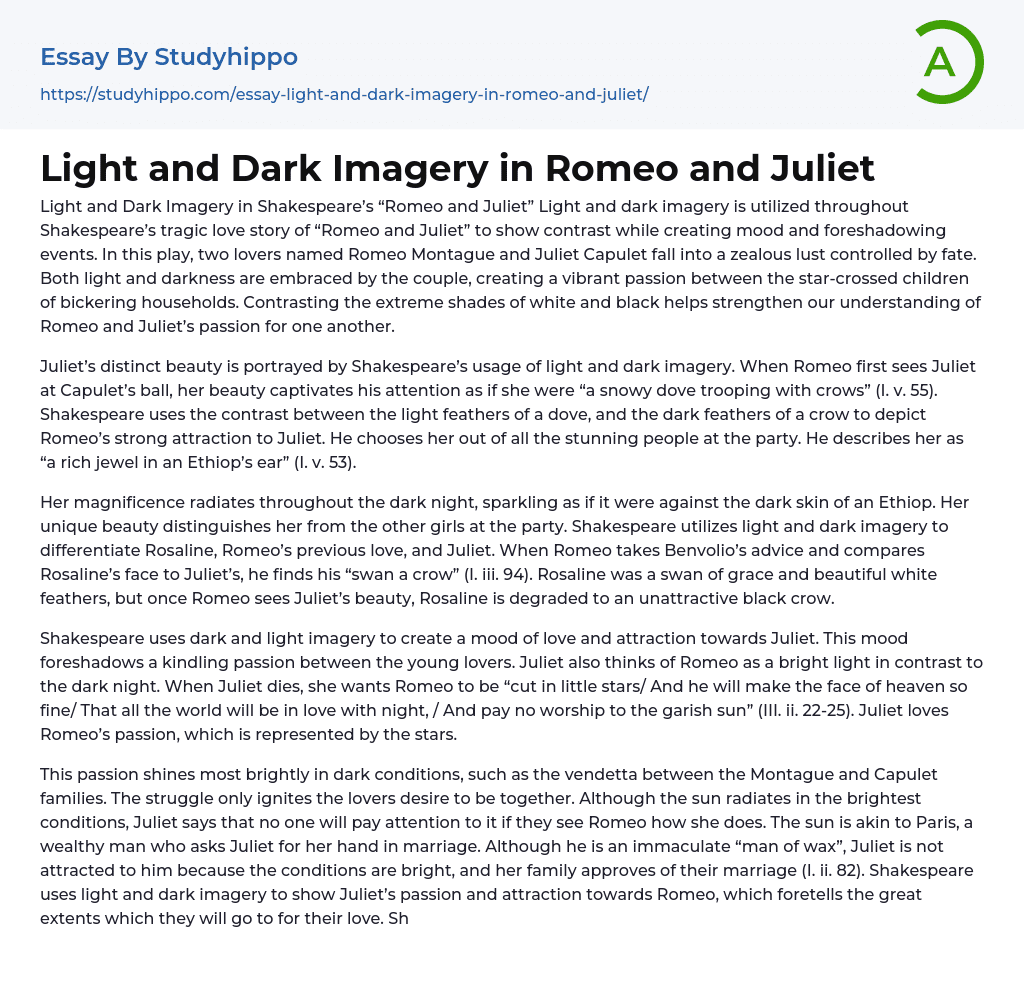Light and Dark Imagery in Shakespeare’s “Romeo and Juliet” Light and dark imagery is utilized throughout Shakespeare’s tragic love story of “Romeo and Juliet” to show contrast while creating mood and foreshadowing events. In this play, two lovers named Romeo Montague and Juliet Capulet fall into a zealous lust controlled by fate. Both light and darkness are embraced by the couple, creating a vibrant passion between the star-crossed children of bickering households. Contrasting the extreme shades of white and black helps strengthen our understanding of Romeo and Juliet’s passion for one another.
Juliet’s distinct beauty is portrayed by Shakespeare’s usage of light and dark imagery. When Romeo first sees Juliet at Capulet’s ball, her beauty captivates his attention as if she were “a snowy dove trooping with crows” (I. v. 55). Shakespeare uses th
...e contrast between the light feathers of a dove, and the dark feathers of a crow to depict Romeo’s strong attraction to Juliet. He chooses her out of all the stunning people at the party. He describes her as “a rich jewel in an Ethiop’s ear” (I. v. 53).
Her magnificence radiates throughout the dark night, sparkling as if it were against the dark skin of an Ethiop. Her unique beauty distinguishes her from the other girls at the party. Shakespeare utilizes light and dark imagery to differentiate Rosaline, Romeo’s previous love, and Juliet. When Romeo takes Benvolio’s advice and compares Rosaline’s face to Juliet’s, he finds his “swan a crow” (I. iii. 94). Rosaline was a swan of grace and beautiful white feathers, but once Romeo sees Juliet’s beauty, Rosaline is degraded to an unattractive black crow.
Shakespeare uses dark and light imagery to
create a mood of love and attraction towards Juliet. This mood foreshadows a kindling passion between the young lovers. Juliet also thinks of Romeo as a bright light in contrast to the dark night. When Juliet dies, she wants Romeo to be “cut in little stars/ And he will make the face of heaven so fine/ That all the world will be in love with night, / And pay no worship to the garish sun” (III. ii. 22-25). Juliet loves Romeo’s passion, which is represented by the stars.
This passion shines most brightly in dark conditions, such as the vendetta between the Montague and Capulet families. The struggle only ignites the lovers desire to be together. Although the sun radiates in the brightest conditions, Juliet says that no one will pay attention to it if they see Romeo how she does. The sun is akin to Paris, a wealthy man who asks Juliet for her hand in marriage. Although he is an immaculate “man of wax”, Juliet is not attracted to him because the conditions are bright, and her family approves of their marriage (I. ii. 82). Shakespeare uses light and dark imagery to show Juliet’s passion and attraction towards Romeo, which foretells the great extents which they will go to for their love. Shakespeare demonstrates Romeo and Juliet’s passion for each other through their actions of altering day and night. At Juliet’s balcony, Romeo describes her as the sun which wards off the “envious moon”, transforming night to day (II. i. 46). In this instance, the sun is looked upon with beauty and hope. The light and dark imagery shows the influence of Juliet’s beauty.
She
is able to chase away the moon and its symbolism of chastity. This power gives her the ability to marry Romeo. When Romeo is forced to leave for exile in the morning, the lovers try to pretend that it is still night, and that the light is actually darkness. Romeo says to Juliet, “More light and light, more dark and dark our woes” (III. v. 36). Shakespeare uses light and dark imagery to show Romeo’s feelings for Juliet. He tries to turn the day into night so he can spend more time with his love. Shakespeare constantly employs light and dark imagery in “Romeo and Juliet”.
At times it creates a grave mood, which predicts their deaths at the end of the play. The darkness is embraced, fueling the lovers’ desire and ardor for each other. The light does not always represent happiness, and the dark does not always symbolize evil. Instead, light and dark imagery is used to show contrasts between two extremes such as comparing the day and night. The opposite colors of white and black are an appropriate way to represent Romeo and Juliet’s love because they are extreme shades, akin to the lovers’ extreme personalities.
- Mercutio essays
- 1984 essays
- A Farewell to Arms essays
- A Good Man Is Hard to Find essays
- A Hanging essays
- A Lesson Before Dying essays
- A Long Way Gone essays
- A Rose For Emily essays
- A Separate Peace essays
- A Tale Of Two Cities essays
- A Very Old Man With Enormous Wings essays
- Adventures Of Huckleberry Finn essays
- Alice in Wonderland essays
- All Quiet on The Western Front essays
- Allegory of the Cave essays
- An occurrence at owl creek bridge essays
- Animal Farm essays
- Anthem essays
- Antigone essays
- Arthur Conan Doyle essays
- As I Lay Dying essays
- Atticus Finch essays
- Barn Burning essays
- Battle Royal essays
- Beauty and The Beast essays
- Beloved essays
- Boo Radley essays
- Brave New World essays
- Candide essays
- Castle essays
- Characters In Hamlet essays
- Characters In Romeo And Juliet essays
- Christmas carol essays
- Chronicle of a Death Foretold essays
- Cinderella essays
- Crime and Punishment essays
- Daisy Miller essays
- Death of a Salesman American Dream essays
- Desdemona essays
- Diary Of A Wimpy Kid essays
- Dracula essays
- Dubliners essays
- Emma essays
- Ender'S Game essays
- Ethan Frome essays
- Eveline essays
- Fahrenheit 451 essays
- First-Person Narrative essays
- Fish Cheeks essays
- Frankenstein essays




